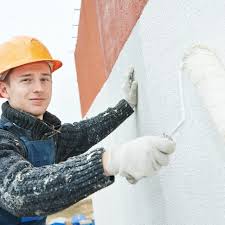Things Your House Painter Wishes You Knew
House painters are responsible for changing or reapplying the color of the interior or exterior of your home, but it isn’t their job to maintain it!
You as the homeowner not only have the responsibility of caring for your walls throughout the life of the paint job, but also making sure your home is fully prepared for the paint job itself.
Check out these tips, and find out some things house painters wish you knew about painting projects:
Preparing for a paint job will take time
If you hire a professional Pennsylvania painting service, they’ll tell you that at least 1/3 of a good quality paint job should be dedicated to preparation. Proper preparation for a paint job will ensure that paint does not get anywhere it isn’t supposed to, and that edges and corners will be nice and smooth.
Do some preparation yourself
Making sure your home is paint-ready is important to a great paint job. Make sure the walls are clean, and don’t forget about corners or hard-to-reach spots. Remove switch plates and outlet covers as well.
It’s okay to ask for touch-ups
Your ideal Allentown, PA painter will encourage you to look over their work once they are finished and let them know of anything you aren’t 100% happy with. Satisfying customers is how they stay in business, after all! Your painter would rather address any issues you have while he is still at your home, rather than having to come back another time.
Let them know of competitive offers
Any painters in Allentown, PA you receive bids from want your business. If you’ve found one you really love but aren’t thrilled on the prices, call them and see if they will be willing to negotiate based on a lower bid you received from another painter.

Essential interior painting steps you won’t want your professional painter to skip
Interior painting is an absolute necessity when it comes to upgrading and revamping your home. If you are looking for a project that will easily elevate your space without breaking the bank, a new interior paint job is the way to go. You don’t have to commit to a full new interior to refresh your home; you can paint an accent wall or a ceiling to have a pleasing effect.
No matter what you’re having painted, there are certain essential interior painting steps you should make sure your professional painter follows in their painting process. If you are too busy and inexperienced to tackle an interior project the right way yourself (and who isn’t?), it is definitely in your best interest to call a professional painter to ensure that your project will be done the right way. A good professional painting company will ensure that all 5 essential interior painting steps in the painting process are done correctly every time.
Planning
The first essential interior painting step is the planning stage. Any interior project, large or small, is going to need some planning to ensure that the project is done correctly. You will need to discuss what areas you want to paint, the color palette of the room, what colors will work well in that space, and what preferences you have on the kind of paint used.
Protecting
Another essential interior painting step is taking care to protect the objects and belongings in your space. Most DIY painters will fail to do this correctly. Once planning is done and you know what you are going to have painted, it’s very important to ensure that everything in your space is properly protected.
Your painter will use large pieces of plastic to cover things to keep paint from splattering all over your floors, cabinets, furniture, and anything else you want to keep free of paint splatters, drops, or spills. Since your walls, trim, or other surfaces may require sanding, your professional painter may choose to remove everything from a room or area before beginning the job.
Prepping
Preparing your walls, ceilings, and other surfaces is the next step that your painting professional will take in the project. It’s an easy way, but one that you don’t want your painter to skip, to ensure that your new paint job lasts for years to come.
Part of preparing the room or area to be painted includes cleaning your walls before the project begins. Painting over grime and dirt will not do you any favors when it comes to the longevity of your project. Before painting, your home may need a few other things, such as sanding rough surfaces, caulking loose baseboards, or patching holes. Your professional painter will take care of these things so your walls are completely ready to paint.
Priming
Priming is an essential interior painting step that many DIYers skip, but that professional painters do every time, for every surface. Priming a wall or ceiling is one of those steps that you definitely don’t want your professional painter to skip. Paint primer creates an even base that your paint adheres to for its best look and for longer wear. Primer also covers dark colors or uneven wall color, due to staining or other factors.
Painting
The final step in the painting process is the actual painting itself. Your professional painter will come to your home with all the supplies needed to protect, prepare, prime, and paint your interior (another benefit of hiring a professional painter, instead of trying it yourself). And there are quite a few supplies needed to successfully carry out even a small painting job.

Things To Expect From A Professional House Painter
- Expert Color Advice
Most of us think we have great taste when it comes to home decor and choosing colors that coordinate; but in reality, most of us are wrong. An experienced, professional house painter can help you choose colors that complement each other well and can show you how light and dark colors can change the way a room looks and feels. In addition, a pro painter can tell you which colors are new and trendy, which is important if you’re thinking of putting your house on the market in the near future.
- Proper Surface Preparation
No matter how expertly paint is applied to a surface, it won’t matter if the surface isn’t prepared ahead of time to receive the paint. A professional house painter understands the process of preparing a home for painting and knows that the steps they have to take can include washing dirty walls, sanding surfaces, filling holes and cracks and applying primer.
- Painting Skill and Expertise
Painting is like golf; everyone who sees it being done thinks it’s easy to do until they try it themselves. Painting the right way requires a great deal of skill that’s acquired through years of experience painting every kind of surface and using every kind of painting technique. A skilled painter knows which types of paints to use, how to properly mask unpainted areas, how to deal with lead paint, how to protect your furniture and flooring and much more.
- The Best Equipment
Unlike most DIY painters, a professional painter will have all of the tools they need to do the job well without interruption. He or she won’t have to leave the job site to run to the hardware store because of forgotten tarps or paint rollers. In addition, they’ll have the highest-quality equipment on hand that they are experienced in using.

How to properly inspect an interior paint job:
• Turn on all the lights in the room. Ideally, you want to do your orientation on a sunny day or high overcast, but this is Vancouver and that is not always possible. If you don’t have the advantage of natural light, you just have to be that much more diligent in your inspection. I bring a light with me when I do my paint inspections.
• Start on one side and work your way around a room. Run you hand over walls and make sure they are smooth. Walls should be sanded between coats and they shouldn’t feel rough or have noticeable bits or lint in the paint.
• Check for major and minor marks on the walls. There shouldn’t be any holes, dents, paint drips, or marks on the walls. I always look for staple marks along the top one to two feet from the ceiling. This is where the drywaller stapled plastic to protect walls when the ceilings were textured and can often be missed by the painter when prepping the walls, since they are above eye level.
• Cut lines should be straight. Check along ceilings, around trim and especially anywhere there is a colour change. Those lines should be straight and smooth.
• Look for paint on the ceiling. I can’t tell you how much this bugs me. It is a mark of an amateur painter or a careless one. The same goes for plugs, light stitches, and baseboard heaters. These should all be paint free.
• Check window and door frames and trim. They should be caulked all the way around, including underneath the windowsill, and painted. Nail holes should be filled and sanded before they are painted. Door and window trim should be smooth. Window frames should also be paint free.
• Caulking should always be done before painting. I’ve seen paint jobs where a painter hid his wavy cut lines by caulking afterward. We were hired to repaint the house when all the caulking started to discolour.
• Check windows for paint drops and spittle on both the inside and outside of the glass. While you are standing at the window, this is a good time to check out some of the exterior painting. Make sure there are no paint drips on the roof and that the inside of fascia boards you can see from the window are painted.
Top Painter Skills
If you are interviewing for a job, make sure you can address these topics. There is a strong likelihood that one or all of these topics will be discussed. And, if you a looking for a career path, do a self-check to see if these skills are, or can be, among your strengths.
Communication Skills
To serve a client’s needs, you must understand what the client wants. Unfortunately, many people do not know how to explain what they want clearly, so you will have to be able to either draw out more exact instructions or use your judgment to fill in the details. Remember that good communication means hearing and respecting what the client wants, not what you think they should want. You can make suggestions, but the owner of the property always has the final say.
Aesthetic Sense
Most clients will need you to make at least some judgment calls in your work, and some will directly ask you for advice. You need a strong sense of what looks good. Think of the job site as a work of art.
Detail-Oriented
What makes a good, or even a great paint job is in the details, such as crisp, clean edges, even coats, and well-adhered layers. A small error can subtly but meaningfully alter the look of the room or building.